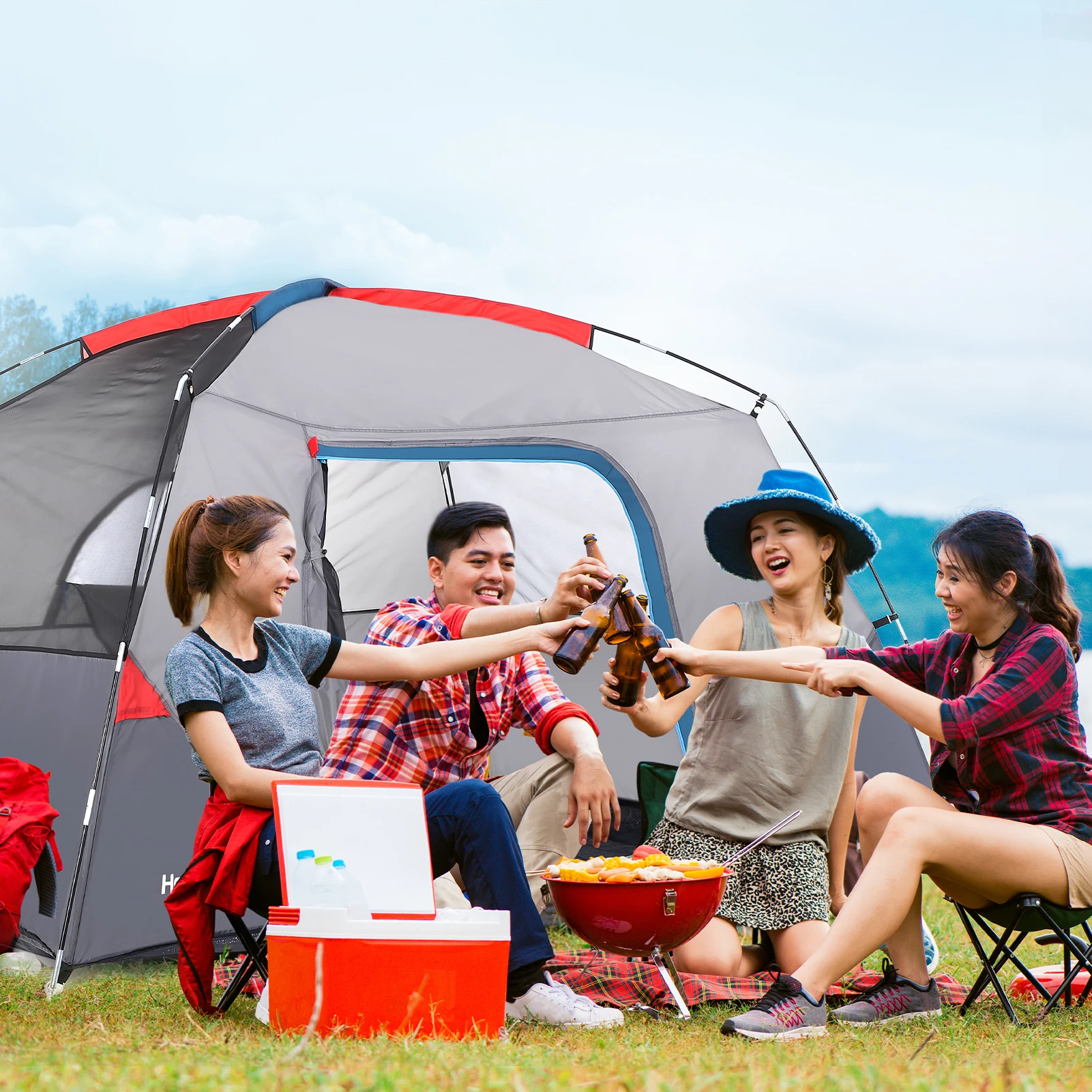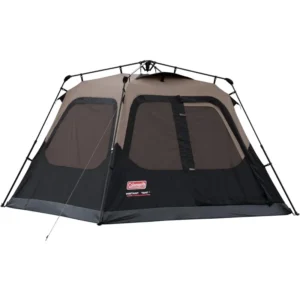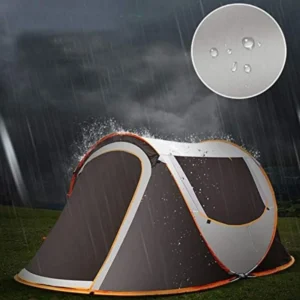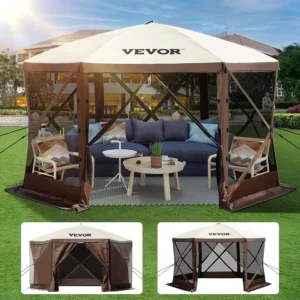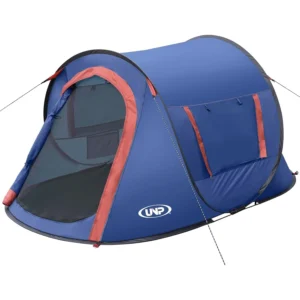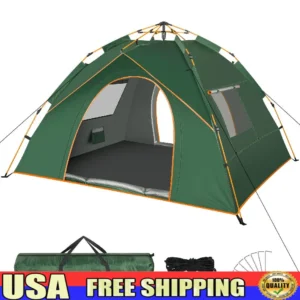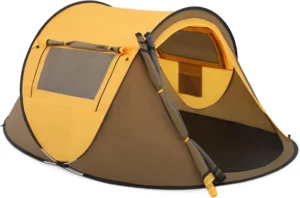Understanding Automatic Tent Technology
Camping has evolved dramatically over the years, with one of the most significant innovations being automatic tents. Unlike traditional tents that require extensive pole assembly, guy line adjustments, and multiple hands, automatic tents offer a dramatically streamlined setup experience. These innovative shelters represent a perfect match for campers who value time and convenience without sacrificing protection.
Modern instant camping tents utilize three primary automatic mechanisms that revolutionize the setup process:
Pop-up technology: These tents use flexible, coiled frames that spring into shape when unpacked. Simply remove the tent from its carrying case, and it “pops” into position within seconds. While setup is nearly instantaneous, folding them back into their compact carrying cases often requires some practice.
Instant/pre-assembled pole technology: These tents feature poles that remain permanently attached to the tent body. The poles use telescoping or hinged designs that extend and lock into place. Setup typically takes 1-2 minutes as you unfold and extend the structure.
Hub-style automatic systems: These more sophisticated designs use central hubs where multiple poles connect. By extending the hub mechanism, all poles deploy simultaneously, creating the tent structure in a coordinated motion, usually taking 1-3 minutes to complete.
The time savings are remarkable: while traditional tents often require 15-20 minutes for setup (longer for beginners or in challenging conditions), automatic tents can be ready in as little as 30 seconds to 2 minutes. This efficiency means more time enjoying your campsite and less time struggling with complicated instructions or poles.
One significant advantage is single-person setup capability. Even larger family-sized automatic tents can typically be erected by one person, eliminating the need for helpers or the frustration of solo setup.
Essential Waterproofing Features
When investing in an outdoor shelter, waterproofing is perhaps the most critical protection feature. Understanding waterproof ratings and technologies helps ensure you stay dry even during unexpected downpours.
The waterproofing effectiveness of tent materials is measured using hydrostatic head (HH) ratings. This rating indicates how much water pressure a fabric can withstand before leaking and is measured in millimeters. Higher numbers indicate better waterproofing performance.
| HH Rating | Weather Protection | Suitable For |
|---|---|---|
| 1500mm | Light rain resistance | Fair weather camping with occasional showers |
| 3000mm | Moderate rainfall protection | Weekend camping, variable conditions |
| 5000mm+ | Heavy rain and harsh conditions | Extended trips, mountain environments |
Premium waterproof pop-up tents utilize several sophisticated materials to achieve optimal water resistance:
Ripstop polyester with PU coating: This material combines tear resistance with a polyurethane coating that creates an effective water barrier. The ripstop weave prevents small tears from expanding, enhancing longevity.
Silicone-treated nylon/polyester (silnylon/silpoly): These advanced fabrics feature silicone impregnation on one or both sides, creating exceptional water repellency while maintaining fabric flexibility and reducing weight.
Oxford canvas with waterproof treatments: Used in premium tents, this heavier material offers outstanding durability and waterproofing, though at a weight penalty compared to synthetic alternatives.
Beyond the fabric itself, several critical construction features contribute to a truly waterproof tent:
Factory-taped or welded seams: Stitching creates tiny holes that can allow water seepage. Quality tents have seams sealed with waterproof tape or heat-welded seams that eliminate potential entry points for moisture.
Full-coverage rainfly: A complete rainfly extends to or beyond the tent’s base, directing water away from the main tent body and doors.
Bathtub floor construction: This design extends floor material several inches up the tent walls, preventing splashing or flowing ground water from entering.
Waterproof zippers and storm flaps: Protected zippers with covering flaps provide additional defense against water infiltration at these vulnerable points.
Understanding tent waterproof ratings will significantly improve your ability to select appropriate protection for your specific camping conditions and expectations.
Premium Structural Features for Weather Resistance
While waterproof fabrics form the first line of defense against the elements, the structural integrity of a tent determines whether it remains standing during challenging weather conditions. Premium waterproof automatic tents incorporate several critical structural elements that enhance their resilience.
High-quality frame and pole materials form the backbone of durable tent designs:
Aircraft-grade aluminum alloy poles: These premium components offer the highest strength-to-weight ratio, providing exceptional stability while keeping weight manageable. They resist bending and breaking even in strong winds.
Premium fiberglass with reinforced connections: More affordable than aluminum but still reliable, quality fiberglass poles include reinforced junction points to prevent splitting under stress. While slightly heavier than aluminum, they offer good performance at a lower price point.
Specialized steel components: Used strategically at critical stress points, steel elements provide superior strength where the tent experiences the greatest forces during wind or when supporting the weight of accumulated rain.
Fabric strength characteristics also contribute significantly to structural integrity:
Fabric denier (D) measurements indicate thread thickness, with higher numbers representing sturdier, more durable materials. Premium tent floors typically range from 150D-210D for excellent puncture resistance.
Thread count (T) specifies how tightly the fabric is woven, with higher counts creating more waterproof, wind-resistant, and durable materials.
Ripstop technology incorporates reinforcement threads in a grid pattern, preventing small tears from expanding into structure-compromising rips.
Advanced wind resistance features further enhance a tent’s ability to withstand challenging conditions:
- Aerodynamic dome and tunnel shapes that minimize wind resistance by allowing air to flow around rather than against broad surfaces
- Quality guy lines and stake systems that anchor the tent securely and distribute wind forces evenly across the structure
- Reinforced anchor points that prevent fabric tearing at connection points during strong gusts
These essential design elements for waterproof tents work together to create a shelter that remains secure and protective regardless of weather conditions.
Ventilation Systems in Waterproof Tents
The paradox of waterproof tents is that the same features keeping water out can inadvertently trap moisture inside. When warm breath from occupants meets cool tent walls, condensation forms—potentially creating interior “rain” despite perfect waterproofing. Quality automatic waterproof tents address this challenge through sophisticated ventilation systems.
Advanced ventilation solutions balance waterproofing with essential airflow:
Mesh windows and doors with waterproof covers allow controlled airflow during fair weather while providing quick protection when rain begins. The highest quality designs feature waterproof coverings that can be positioned to create protected ventilation even during rainfall.
Strategic ground vents positioned to create airflow paths from bottom to top of the tent help evacuate warm, moist air. These vents incorporate special designs to prevent water entry while maintaining air movement.
Roof ventilation systems often incorporate protected vents at the highest points of the tent where warm, moist air naturally collects. These systems include rain shields that allow air to escape while preventing water from entering.
Double-wall design creates a crucial separation between the inner tent (typically breathable) and the waterproof outer rainfly. This gap allows moisture to escape the living area and condense on the rainfly rather than dripping onto occupants and gear.
Without proper ventilation, a 2-person tent can accumulate 1-2 cups of condensation overnight—enough to dampen sleeping bags and clothing. This common issue appears in many waterproofing issues with pop-up tents when ventilation is inadequate.
The best automatic waterproof tents achieve a sophisticated balance between complete weather protection and necessary airflow, ensuring occupants remain both dry and comfortable throughout their outdoor experience.
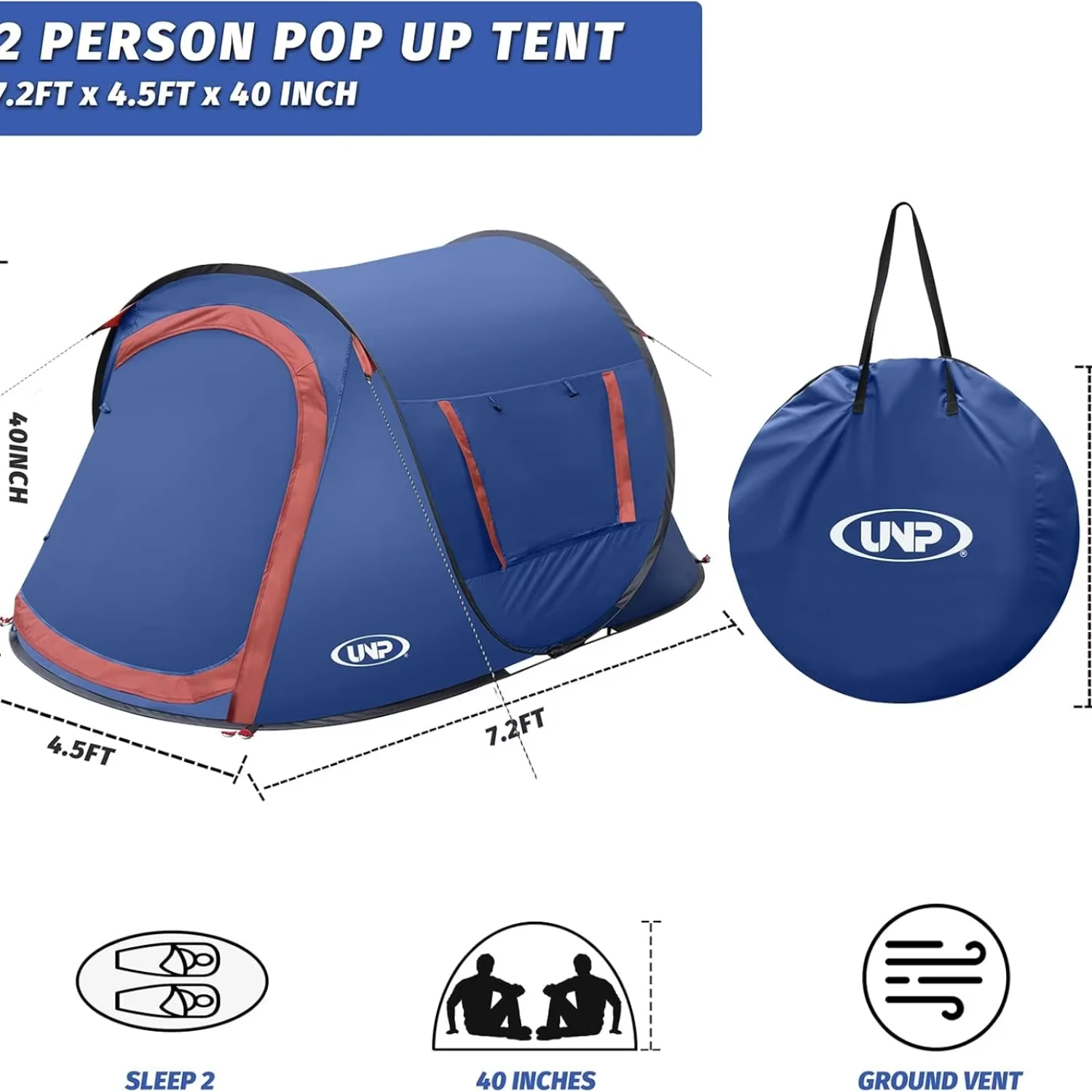
Interior Space and Comfort Design
Beyond protection from the elements, a quality tent must provide comfortable living space for its occupants. Understanding how capacity ratings translate to actual usable space helps select the right waterproof automatic tent for your needs.
Tent capacity ratings indicate the maximum number of people who can sleep inside using standard sleeping pads placed side by side. However, these ratings rarely account for gear storage or comfortable movement space. When evaluating interior dimensions, consider:
- Floor dimensions for different capacity ratings:
- 2-person tent: Typically 7 ft × 5 ft (2.1m × 1.5m) floor space
- 4-person tent: Typically 9 ft × 7 ft (2.7m × 2.1m) floor space
6-person tent: Typically 12 ft × 9 ft (3.6m × 2.7m) floor space
Peak interior height determines whether occupants can sit upright or stand inside. Most 2-person tents offer around 4 ft (1.2m) of headroom, while family-sized models may provide 5-6 ft (1.5-1.8m) of standing height in portions of the tent.
Thoughtful interior design elements significantly enhance comfort and usability:
Multi-door designs allow occupants to enter and exit without climbing over companions and gear, particularly valuable for midnight bathroom trips.
Strategic window placement provides natural lighting and views while maintaining privacy where needed.
Integrated storage solutions including hanging pockets, gear lofts, and lantern hooks keep essentials organized and easily accessible while maximizing floor space.
Many premium models include vestibules or awning extensions that create protected outdoor space for cooking, gear storage, or relaxing outside the main tent body while remaining sheltered from sun or rain.
Choosing the appropriate tent size for two people or more requires careful consideration of how you’ll use the space, including sleeping arrangements, gear storage requirements, and duration of stay.
Easy Setup Camping Tent, Instant Camping Tent
Instant Cabin Tent Double Layer Canvas 1-Minute Setup Spacious Family Camping Shelter with Air Vents$308.10 Select options This product has multiple variants. The options may be chosen on the product pagePop Up Dome Tent, Waterproof Pop Up Tent
$218.89 Select options This product has multiple variants. The options may be chosen on the product page- $633.01 Select options This product has multiple variants. The options may be chosen on the product page
Easy Setup Camping Tent, Instant Camping Tent, Lightweight Pop Up Tent, Pop Up Dome Tent
$252.30 Select options This product has multiple variants. The options may be chosen on the product pageDome Camping Tent, Easy Setup Camping Tent, Pop Up Dome Tent, Waterproof Pop Up Tent
$162.68 Select options This product has multiple variants. The options may be chosen on the product pageLightweight Pop Up Tent, Pop Up Dome Tent, Ultralight Backpacking Tent, Waterproof Pop Up Tent
$210.64 Select options This product has multiple variants. The options may be chosen on the product page
Materials and Durability Analysis
The materials used in waterproof automatic tents significantly impact their performance, weight, and longevity. Each fabric option offers distinct advantages worth considering before making an investment.
Premium tent materials each bring unique properties to outdoor shelters:
Polyester offers excellent UV resistance and minimal stretching when wet, maintaining taut pitching even during prolonged rain. Higher-quality polyester tents use 68D to 75D fabric for the rainfly and walls, offering good durability without excessive weight.
Nylon provides superior strength-to-weight ratio, making it ideal for backpacking tents where every ounce matters. However, nylon absorbs more water than polyester and can sag when wet, requiring adjustment during rainstorms. Premium nylon tents often use 40D to 70D material depending on the balance of weight versus durability.
Oxford canvas delivers exceptional durability and natural breathability but comes with substantial weight penalties. This traditional material excels in extreme conditions and can last decades with proper care. Typically using 600D or higher material weight, these tents prioritize longevity over portability.
Floor materials require special consideration as they contact abrasive surfaces and face pressure from both occupants and ground moisture:
Heavy-duty polyethylene (PE) floors provide excellent puncture and water resistance but add weight and sometimes bulk.
Oxford polyester floors with high denier counts (often 150D-210D) balance protection with weight considerations.
Long-term durability depends on several additional factors beyond base materials:
UV protection coatings significantly extend fabric life, preventing the degradation that eventually leads to leaking and fabric failure.
Reinforcement in high-stress areas like pole attachment points, door corners, and stake loops prevents premature failure where tension concentrates.
Quality of automatic mechanisms determines whether the convenience features will continue functioning after repeated use.
Understanding different materials used in waterproof hiking gear helps evaluate which options best suit your specific adventure requirements and environmental conditions.
Advanced Waterproofing Technologies
Beyond basic waterproofing features, premium automatic tents incorporate sophisticated technologies that significantly enhance weather resistance in challenging conditions. These advanced systems represent the difference between staying mostly dry and remaining completely protected regardless of weather intensity.
Innovative waterproofing technologies in high-end tents include:
Heat-sealed seam technology uses thermal bonding rather than traditional stitching and taping. This process creates a molecular bond between fabric sections that is 20-30% more effective than conventional taped seams, virtually eliminating seepage at these vulnerable junctions.
Double-layer waterproofing systems incorporate both a durable water repellent (DWR) outer coating and an interior polyurethane or silicone layer, creating redundant protection if the outer layer becomes compromised.
Specialized corner construction with extra reinforcement and sealed design prevents water infiltration at these traditionally vulnerable junctions where multiple panels meet.
Advanced rainfly designs further enhance protection:
Full-coverage designs extend beyond the tent body to the ground, creating complete protection versus partial coverage flies that leave portions of the inner tent exposed.
Tension adjustment systems allow fine-tuning of rainfly tautness to optimize water runoff and prevent pooling, a critical feature during sustained rainfall.
Integration with automatic frame systems ensures the rainfly deploys correctly with the tent structure, maintaining proper coverage and tension regardless of setup conditions.
Floor-wall junction protection represents one of the most critical waterproofing zones, addressed through:
- Elevated “bathtub” floor designs that extend waterproof floor material several inches up the tent walls
- Sealed or welded rather than stitched connections at these junctions
- Reinforced design elements that prevent stretching or separation under occupant weight
These technologies align with the premium approach found in many essential waterproof gear items for backpackers, where sophisticated protection meets practical field performance.
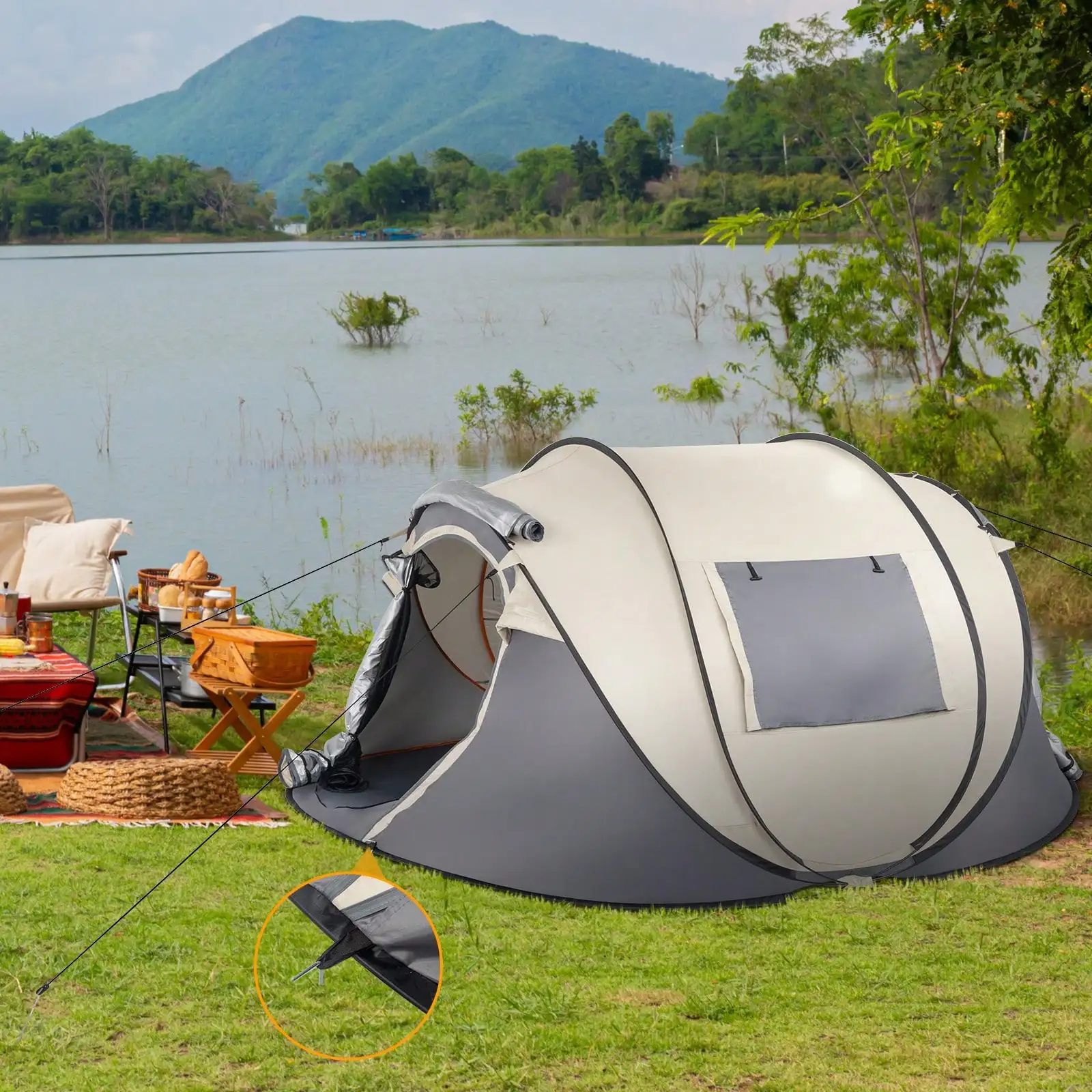
Portability and Transportation Features
The convenience of automatic setup is complemented by thoughtful portability features that make these tents practical for various adventures. Weight considerations and packing dimensions play crucial roles in the overall user experience.
Weight ranges for automatic waterproof tents vary significantly based on capacity and construction quality:
- 2-person automatic waterproof tents: 4-7 lbs (1.8-3.2 kg)
- 4-person automatic waterproof tents: 8-12 lbs (3.6-5.4 kg)
- 6-person automatic waterproof tents: 15-25 lbs (6.8-11.3 kg)
Packed dimensions and shapes differ based on the automatic mechanism employed:
Disc-shaped pop-up tent packs are typically flat circular packages ranging from 24-36 inches (60-90 cm) in diameter. While easy to store in car trunks, their unusual shape can be challenging for backpack transport.
Rectangular pole-based systems fold into more conventional elongated packages approximately 24-30 inches (60-75 cm) long and 6-8 inches (15-20 cm) in diameter, fitting better in standard luggage or alongside backpacking gear.
Premium compression carrying cases include straps and buckles that reduce packed volume by 15-25%, making transport and storage significantly more manageable.
Quality tents incorporate thoughtful carrying features:
- Backpack-style straps distribute weight comfortably during longer carrying distances
- Padded handle designs prevent hand fatigue during shorter transportation
- Compression straps not only reduce volume but also prevent internal components from shifting during transit
These features become particularly important when camping involves hiking to reach sites rather than car camping. Mastering tent packing techniques can further improve portability by optimizing how the tent fits in its carrying case and integrates with other gear.
Choosing the Right Waterproof Automatic Tent
Selecting the ideal waterproof automatic tent requires matching specific features to your unique camping needs. Different environments and usage scenarios demand particular attributes for optimal protection and convenience.
For weekend family camping trips, prioritize:
– Generous interior space with standing height at center
– Multiple rooms or dividers for privacy
– Easy setup that accommodates helpers of various ages
– Durable materials that withstand enthusiastic use
Festival and event camping benefits from:
– Highly visible colors or distinctive designs for easy location
– Enhanced security features like lockable zippers
– Quick setup and takedown to accommodate event schedules
– Good ventilation for potentially crowded conditions
Coastal and beach environments demand:
– Superior UV protection ratings
– Sand pockets rather than traditional stakes for anchoring
– Enhanced corrosion resistance for hardware exposed to salt air
– Extra guy lines for stability in coastal winds
Multi-season camping requires:
– Higher hydrostatic head ratings (4000mm+)
– Stronger pole materials (aluminum rather than fiberglass)
– Dome or geodesic designs that shed snow
– Vestibule space for wet gear storage
When balancing automatic setup convenience with weather protection, consider that the most rapid setup systems (pop-ups) sometimes offer less stability in extreme conditions than hub-style or pre-assembled pole systems that take slightly longer to erect.
Feature prioritization should reflect your specific circumstances:
– Solo travelers might sacrifice some space for significantly lighter weight
– Families need to balance capacity with manageable packed size
– Extreme weather campers should prioritize structural integrity over setup speed
– Budget constraints might require compromising on certain premium features
Understanding shelter options for two campers or larger groups helps align tent selection with practical needs rather than marketing claims.
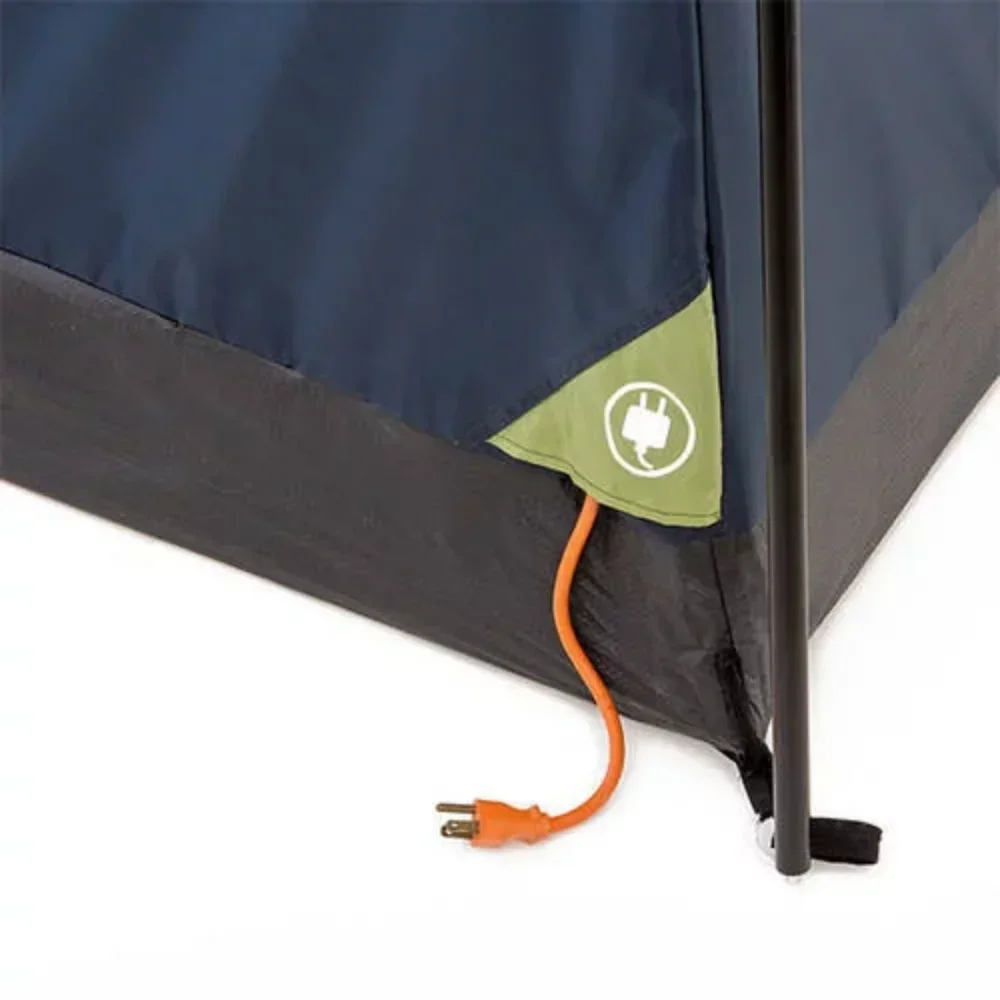
Maintenance Tips for Waterproof Automatic Tents
Proper maintenance significantly extends the life and performance of waterproof automatic tents. Following these essential care practices ensures your investment delivers reliable protection for many adventures to come.
Clean properly after each trip: Remove dirt and debris using lukewarm water and a soft brush or sponge. Avoid harsh detergents or cleaning agents that can damage waterproof coatings. Focus especially on zippers and pole connection points where grime accumulates.
Dry completely before storage: Even slightly damp tents can develop mildew within 24-48 hours, permanently damaging waterproof coatings and creating health hazards. Set up the tent in a dry area (indoors if possible) and ensure all surfaces are completely dry before packing.
Store in cool, dry conditions: Avoid attics, garages, or basements with temperature fluctuations or humidity. Store loosely rather than tightly compressed to prevent permanent creasing of waterproof membranes.
Reapply waterproofing treatments when needed: Water should bead up and roll off tent surfaces. When you notice water beginning to soak into the fabric, it’s time to reapply appropriate DWR treatments. This typically becomes necessary every 1-2 seasons depending on usage.
Maintain seam sealing: Inspect seams regularly and reapply seam sealer to areas showing wear or leakage. Focus particularly on floor seams and rainfly connection points where stress concentrates.
For automatic mechanisms, consider these specialized maintenance steps:
- Apply silicone spray lubricant to moving parts if they begin to stick
- Operate deployment mechanisms gently, avoiding jerky or forced movements
- Adjust tension systems periodically to maintain optimal performance
- Inspect automatic components for wear and address minor issues before they become major failures
Following proper waterproofing gear care techniques ensures your tent remains a reliable shelter rather than becoming a disappointing investment after just a few uses.
Is a Waterproof Automatic Tent Worth the Investment?
When considering the premium price point of high-quality waterproof automatic tents, many outdoor enthusiasts question whether the investment delivers corresponding value. The answer depends largely on your specific camping priorities and patterns.
For frequent campers, the time savings alone can justify the cost. Over a camping season with 5-10 weekend trips, an automatic tent might save 5-20 hours of cumulative setup and takedown time. This translates to significantly more relaxation and enjoyment during precious outdoor time.
Weather protection confidence represents another major value factor. Premium waterproof automatic tents from trusted brands like Explore Elements deliver reliable performance even during unexpected storms, potentially saving thousands of dollars in damaged gear and preventing dangerous exposure situations.
The convenience factor extends beyond just setup time. After long travel days or hikes, the ability to establish shelter quickly without frustration provides genuine psychological benefits. For families with children, this quick transition to “camp life” can transform the camping experience.
However, simpler tents might suffice for:
– Very occasional campers (1-2 trips annually)
– Fair-weather campers who carefully select optimal conditions
– Ultra-lightweight backpackers where every ounce matters
– Budget-constrained beginners testing their interest in outdoor activities
Premium features that particularly justify higher price points include:
– True one-person setup capability for larger tents
– Genuine all-weather protection with proven performance
– Outstanding ventilation systems that prevent condensation
– Durability that delivers years rather than seasons of use
Many experienced campers find that quick-setup tent features deliver value far beyond their additional cost, particularly when factoring in the long service life of quality equipment.

